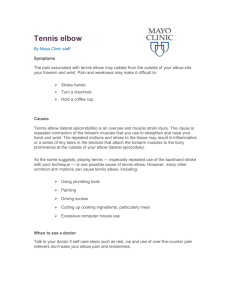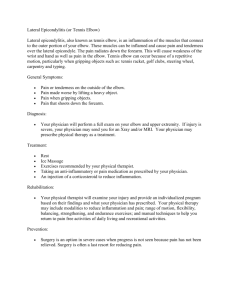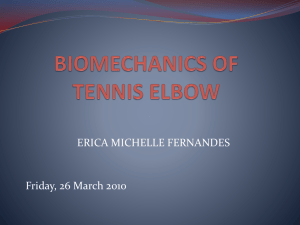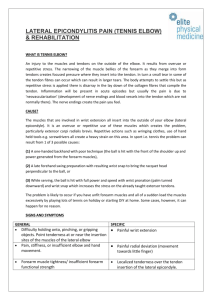How Can You Help Your Healing Fracture?
advertisement
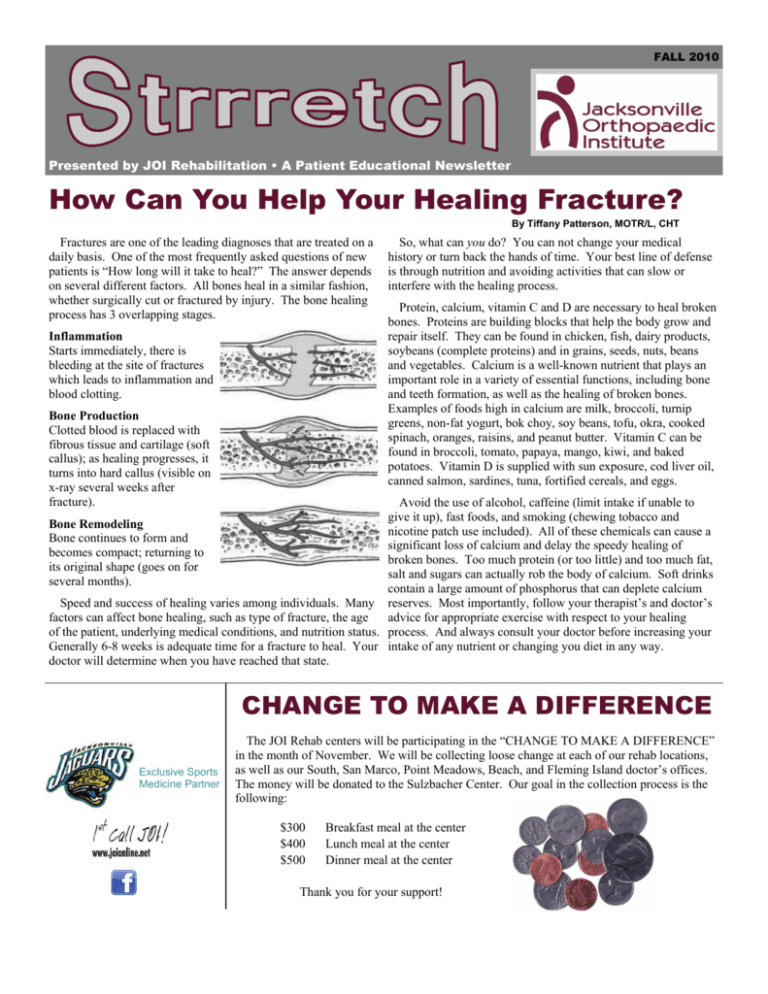
FALL 2010 Presented by JOI Rehabilitation • A Patient Educational Newsletter How Can You Help Your Healing Fracture? By Tiffany Patterson, MOTR/L, CHT Fractures are one of the leading diagnoses that are treated on a daily basis. One of the most frequently asked questions of new patients is “How long will it take to heal?” The answer depends on several different factors. All bones heal in a similar fashion, whether surgically cut or fractured by injury. The bone healing process has 3 overlapping stages. Inflammation Starts immediately, there is bleeding at the site of fractures which leads to inflammation and blood clotting. Bone Production Clotted blood is replaced with fibrous tissue and cartilage (soft callus); as healing progresses, it turns into hard callus (visible on x-ray several weeks after fracture). So, what can you do? You can not change your medical history or turn back the hands of time. Your best line of defense is through nutrition and avoiding activities that can slow or interfere with the healing process. Protein, calcium, vitamin C and D are necessary to heal broken bones. Proteins are building blocks that help the body grow and repair itself. They can be found in chicken, fish, dairy products, soybeans (complete proteins) and in grains, seeds, nuts, beans and vegetables. Calcium is a well-known nutrient that plays an important role in a variety of essential functions, including bone and teeth formation, as well as the healing of broken bones. Examples of foods high in calcium are milk, broccoli, turnip greens, non-fat yogurt, bok choy, soy beans, tofu, okra, cooked spinach, oranges, raisins, and peanut butter. Vitamin C can be found in broccoli, tomato, papaya, mango, kiwi, and baked potatoes. Vitamin D is supplied with sun exposure, cod liver oil, canned salmon, sardines, tuna, fortified cereals, and eggs. Avoid the use of alcohol, caffeine (limit intake if unable to give it up), fast foods, and smoking (chewing tobacco and Bone Remodeling nicotine patch use included). All of these chemicals can cause a Bone continues to form and significant loss of calcium and delay the speedy healing of becomes compact; returning to broken bones. Too much protein (or too little) and too much fat, its original shape (goes on for salt and sugars can actually rob the body of calcium. Soft drinks several months). contain a large amount of phosphorus that can deplete calcium Speed and success of healing varies among individuals. Many reserves. Most importantly, follow your therapist’s and doctor’s factors can affect bone healing, such as type of fracture, the age advice for appropriate exercise with respect to your healing of the patient, underlying medical conditions, and nutrition status. process. And always consult your doctor before increasing your Generally 6-8 weeks is adequate time for a fracture to heal. Your intake of any nutrient or changing you diet in any way. doctor will determine when you have reached that state. CHANGE TO MAKE A DIFFERENCE Exclusive Sports Medicine Partner The JOI Rehab centers will be participating in the “CHANGE TO MAKE A DIFFERENCE” in the month of November. We will be collecting loose change at each of our rehab locations, as well as our South, San Marco, Point Meadows, Beach, and Fleming Island doctor’s offices. The money will be donated to the Sulzbacher Center. Our goal in the collection process is the following: $300 $400 $500 Breakfast meal at the center Lunch meal at the center Dinner meal at the center Thank you for your support! Lower Back Pain By Pete Conrique, DPT Low back pain affects many people in America. It can occur in a variety of ways. These can range from simple strains due to improper lifting to fractures due to direct trauma, such as falling. However, the incidence of chronic pain increases as our population ages and as our activities of daily living increase, and as we participate in repetitive activities, such as running. One area that can often times be over looked is the occurrence of a leg length discrepancy. A patient who possesses a leg length discrepancy can experience a variety of pains such as low back pain and hip pain. Leg length discrepancy can result in greater stress upon your lumbar spine. The application of a heel lift or an orthotic device with a heel lift can result in decreased lumbar stress and a reduction of pain. These can be prescribed by your doctor and fit by many JOI clinicians. What is Kinesio ® Tape? Credits: Stanford School of Medicine The occurrence of a leg length discrepancy is not the only finding that can benefit with use of an orthotic device. People who possess increased pronation during ambulation may also be candidates for an orthotic device in order to alleviate chronic low back pain. Chronic low back pain can significantly limit our ability to work, play and perform activities of daily living. Increased pronation results in a domino affect up to the back, which can affect the patient’s posture as well as their mechanics with walking. The more we walk and the more stress we place on our back due to increased walking or due to our occupations and environment, the more abnormal stress is placed on our back. The use of orthotics can provide more control of the foot and help correct the altered posture and improve their gait. The importance of gait, foot mechanics as well as leg length can play an important role in decreasing our low back pain and increasing our functional level. By Robert Lim, PTA The Kinesio® Taping Method was first seen in the 1980s when it was invented by a Japanese chiropractor named Dr. Kenzo Kase. The tape, which can be seen in beige, blue, hot pink and black, is made from a cotton strip with an acrylic adhesive (non latex) to mimic the qualities of human skin. The tape is water resistant and can be worn for 24 hours for 3 to 5 continuous days. Kinesio® tape can be used during any phase of an injury (acute/chronic) to help initally reduce swelling and inflammation by improving circulation and reduce pain by taking pressure off pain receptors. Also, Kinesio® tape is used to help promote correct muscle and joint function as well as assisting and giving support to muscles to prevent over-contraction. Kinesio® tape technique allows the injured body part to work in its full range of motion. This technique will not affect the biomechanics of any athlete or patient and is very safe to use on the pediatric to geriatric populations. Kinesio® tape can be applied on the body starting from the neck, shoulder, elbow, wrist, fingers, mid back, lower back, hips, knees, ankles, to even the toes and other parts of the body. Credits: Cooley Rehab Kinesio® tape is used by physical therapists, physical therapist In 2008, professional women’s beach volleyball players Kerri assistants, athletic trainers, occupational therapists, occupational Walsh and Misty May competed in the Beijing Summer Olympic therapist assistants, chiropractors, and massage therapists . So, Games. Many people to this day still question, “What was the ask your therapist at all of our Jacksonville Orthopaedic Institute black tape on Kerri Walsh’s shoulder?” The black tape on her Rehabilitation clinics if the Kinesio® Taping Method will be shoulder is a 20 - plus - year practice called the Kinesio® Taping used in your course of treatment. Method. Tennis Elbow By Joanna Starkey, DPT, CHT Lateral epicondylitis or “tennis elbow” is the most common injury at the elbow. The name is somewhat of a misnomer as rarely is tennis the cause. It occurs most often between the ages of 30 and 50, and is found more frequently in the dominant arm. The causes of tennis elbow can vary- the most common cause is a cumulative or degenerative overuse of the wrist extensor muscles, in particular the Extensor Carpi Radialis Brevis or ECRB (See fig 1). This can be an acute repetitive activity, such as painting a room or a gradual onset after years of use. Although less common, tennis elbow can also be caused by an acute trauma to the outside of the elbow (called the lateral epicondyle) that can damage the tendon and lead to symptoms of tennis elbow. Symptoms of tennis elbow usually involve lateral or outside elbow pain that can radiate into the forearm and wrist. Pain is usually with gripping, lifting, and basic everyday activities. Symptoms usually have a gradual onset of pain, progressing with activity. At the beginning of onset the pain is minimal and usually just during activity. Patients often tend to “work thru” the pain instead of resting which can lead to the progression of damage to the tendon, until the pain can be severe enough to limit all activities. This is one time where pain is a useful guide - if it hurts, don’t do it. Rest and activity modification are the most effective treatments. Other treatments will also be discussed later as well. To understand how to effectively treat tennis elbow you need understand the anatomy and mechanics of the ECRB and how to modify your activities to decrease force on this muscle. The ECRB muscle originates above the elbow and crosses the elbow joint traveling down the forearm to attach at the base of the index finger. This muscle is responsible for extending and deviating the wrist, but can be active with elbow motion as well. While this muscle creates wrist extension, the muscle is also active when you are flexing and gripping your wrist and hand. This is because the muscle co-contracts or stabilizes the wrist, so that you have a support from which to grip from. Often the extensor muscles (ECRB) are weaker than the flexor (grip strength) and can create a muscle imbalance and more stress on the ECRB muscle. This explains why most patients complain of pain with griping activities such as shaking hands, lifting groceries, etc. Fig 1 Because this muscle crosses more than one joint (the elbow and wrist) the forces on the muscle vary based on the position of the elbow and wrist. When your elbow is bent and the wrist is extended the muscle is in a very shortened position and little stress is placed on its attachment sites when it contracts. However, when the elbow is extended while the wrist is flexed, the muscle is then being stretched and a contraction at this position would put significantly more force at its attachment site. This stress causes small micro tears of the tendon. These micro tears cause small amounts of swelling and pain and if micro trauma continues the tears can become larger causing the tendon quality to decrease and fray. Treatment for tennis elbow is largely activity modification. Avoiding stress to the ECRB by avoiding picking up objects with the palm down and elbow straight is key. Common things to avoid are reaching over a car seat to grab a bag, stretching around the desk to reach the phone, etc. Try to always lift with the wrist in neutral and the elbows bent. A stretching program is also very helpful. Painful muscles often tend to spasm or tighten up. If a muscle is tight, it will place more force on its attachment sites when you try to stretch the muscle. Below are some stretches developed to help slowly stretch the ECRB. The key to remember is that the stretch should last at least 20-30 seconds to have a lasting effect, and that it should not be a very painful activity. Remember that these should be pain free. Please perform stretches 2-3 times each, 3-4 time per day and perform strengthening 1 time per day if pain free for at least two days. • Straighten elbow as far as possible without pain. Using opposite hand gently bend wrist down until you feel a light stretch. • If too painful perform with elbow bent and or palm rotated towards center instead of down • To progress, make a loose fist and rotate palm down and even out into full pronation • Using a soup can or light weight lift hand up and slowly lower back down. • Make sure elbow is bent close to 90 deg and palms is towards ceiling • Perform 3-5 sets of 10 repetitions • Using a soup can or light weight lift hand up and slowly lower back down. • Make sure elbow is bent close to 90 deg and palm is towards floor • Perform 3-5 sets of 10 repetitions • Straighten elbow as far as possible without pain. • Using opposite hand gently extend wrist until you feel a light stretch. • If too painful perform with elbow bent and or palm towards floor • Grip a light stress ball, silly putty or therapy putty and squeeze • Pull and grip for approximately 5-10 minutes Tennis Elbow Cont. Your outcome matters! Choose JOI, the region’s leaders in effective, healthy rehabilitation . JOI Rehabilitation has nine convenient locations to serve you. Beaches 436 Jacksonville Drive Jacksonville Beach, FL 32250 P: 904.247.3324 F: 904.247.3926 North 12961 North Main Street Suite 201 & 202 Jacksonville, FL 32218 P: 904.757.2474 F: 904.757.5541 Point Meadows (Gate Parkway & 9A) 7740 Point Meadows Drive Suite 1 & 2 Jacksonville, FL 32218 P: 904.564.9594 F: 904.564.9687 Riverside 4339 Roosevelt Boulevard Suite 300 Jacksonville, FL 32210 P: 904.389.8570 F: 904.389.8599 San Marco 1325 San Marco Boulevard Suite 102 Jacksonville, FL 32207 P: 904.858.7045 F: 904.858.7047 South 14985 Old St. Augustine Road, Suite 106 Jacksonville, FL 32258 P: 904.288.9491 F: 904.288.9698 University 5737 Barnhill Drive Building B, Suite 204 Jacksonville, FL 32207 P: 904.733.9948 F: 904.733.9984 Mandarin 12276 San Jose Blvd Suite 716 & 717 Jacksonville, FL 32223 P: 904.288.9604 F: 904.288.9643 Orange Park 1845 Town Center Blvd Suite 410 Fleming Island, FL 32003 P: 904.621.0396 F: 904.621.0397 When in the acute stages, modalities that can help decrease the inflammation can be helpful. This can include anti-inflammatory medication, ice massage, and electrical stimulation. When more chronic, some will recommend moist heat or ultrasound (a deeper heat) to the muscle to help increase the blood flow and extensibility of the muscle. Some studies have also found that using a form of electrical stimulation call High Volt Galvanic can increase tendon healing. Wrist braces can help keep you from extending the wrist as often and rest the muscle. Counterforce straps are also marketed for helping tennis elbow, although actual results vary greatly. This is a band that is placed over the muscle belly about 1.5 inches down from the elbow joint. It is should be snug enough to act as a reminder to not contract the muscle, but not compromise blood-flow to the area. If you are active in racquet sports, such as tennis, you need to make sure your racquet is fitted properly to avoid extra stress on the ECRB, and you are often recommended to avoid sports for 4-6 weeks, if symptoms are severe. Once you have been pain free for at least two weeks you can begin a very gentle progressive strengthening program for the wrist. The key is again to start slowly and avoid pain. The elbow should always be bent to allow less stress to the ECRB and the focus is on endurance (light weight and high reps) rather than heavy strengthening. If the above treatments are not helpful, your doctor may recommend a steroid injection. While the injection itself is not comfortable, steroids help take away the swelling and decrease the pain around the tendon insertion. Steroid injections are very effective at relieving the pain, but if activity is not modified the symptoms will often return. Most doctors will limit the number of injections to avoid further damage to the tendon. In a very few cases injections and conservative measures are not helpful and surgical debridement is required. Please contact your JOI clinician or doctor for any questions. Meet Our Staff Pete Conrique - North Bachelor of Science in Athletic Training (Indiana University, 1991) Master's Degree in Kinesiology (Penn State University, 1993) Doctor of Physical Therapy (University of St. Augustine, 2010) Pete was a graduate assistant at Penn State University working with the track and field cross country, tennis and cheerleading while studying Kinesiology. He worked briefly with the Kansas City Royals in Fort Meyers before coming to Jacksonville, FL. Pete has worked as an Athetic Trainer in both outreach and clinical settings for more than 16 years. He treats many orthopaedic conditions and specializes in foot and ankle, as well as casting for custom orthotics. Pete joined JOI in 2008. Congratulations Pete! The Doctor of Physical Therapy (DPT) degree serves as a credential, conferred by 189 of the nation's 200 accredited physical therapy degree programs. It signifies completion of the current requirements needed to enter the profession and represents the completion of a comprehensive program and the fulfillment of high standards of clinical performance in professional preparation. This is the highest attainable degree in the physical therapy field. A graduate requires seven to eight years of upper level education. Pete joins 11 other clinicians at JOI with this degree.
